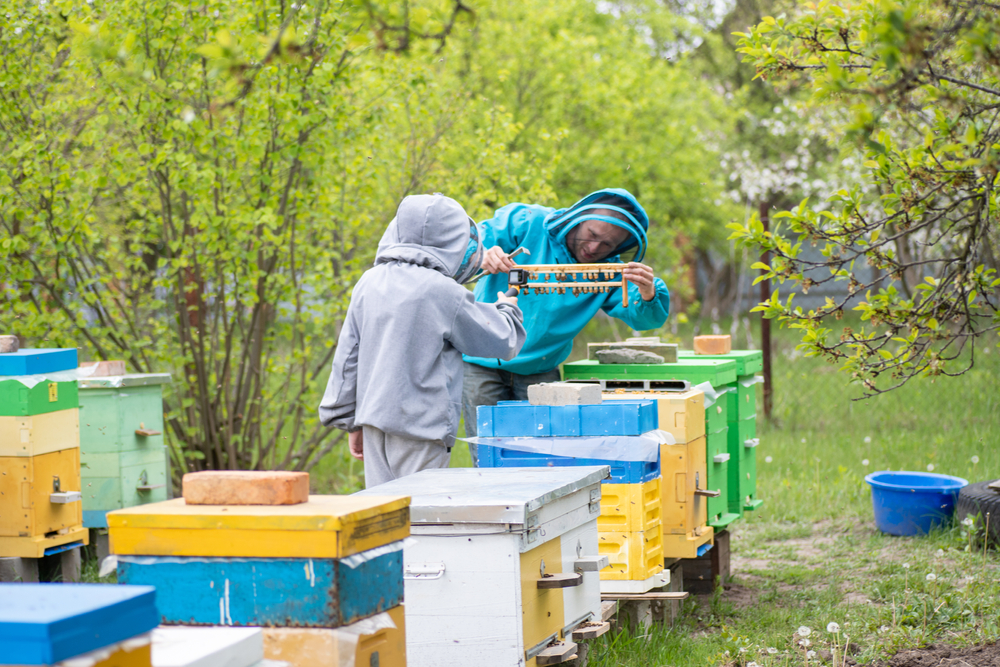Father and Son Build 50,000 New Beehive Colonies Around the World

In 2015, Stuart and Cedar Anderson, a father-and-son team from Australia, introduced a game-changing invention to the world of beekeeping: the Flow Hive. This innovative design simplifies honey harvesting, allowing it to be done straight from the hive without disturbing the bees—a breakthrough for both novice and experienced beekeepers.
The Flow Hive quickly gained attention worldwide, celebrated for its focus on sustainable practices and its potential to inspire a deeper connection with nature. With thousands of customers already embracing the technology, the Andersons continue to redefine what it means to coexist harmoniously with the environment.
Making Beekeeping Easier and Kinder with Flow Hive
If you’ve ever tried traditional beekeeping, you know it can be a sticky, chaotic process. Extracting honey often means cracking open the hive, handling costly processing tools, and dealing with honey splattering everywhere. Sadly, it can also harm the very bees you’re trying to nurture. For many, the effort, expense, and disruption can make beekeeping feel out of reach.
That’s where the Flow Hive changes everything. Created by Stuart and Cedar Anderson, this innovative hive design offers a simple and stress-free way to harvest honey. As Cedar puts it, “Now you can simply turn a tap, sit back, and enjoy with your friends and family as you watch the honey pour directly out of your hive and into the jar.” There’s no mess, no extra equipment, and most importantly, no unnecessary harm to the bees.
This design isn’t just practical—it’s a game-changer. By making beekeeping more accessible and humane, the Andersons have opened the door for more people to care for bees and contribute to their survival. It’s a win for hobbyists, the environment, and the bees themselves.
How Did Flow Hive Start?
It all started with a young boy’s compassion. As a child, Cedar Anderson couldn’t stand the idea of bees being harmed during honey harvesting—a process his family had practiced for three generations. Imagine a boy raised to admire these social creatures, only to see them hurt as part of the work. That feeling stuck with him. “The first idea was simply that there must be a better way, and I’d been thinking about that from a very young age,” Cedar recalled.
Years later, that childhood idea took shape as the Flow Hive prototype, which went on to break crowdfunding records. Within 10 minutes on Indiegogo, the campaign exceeded its $70,000 goal. In just 15 minutes, it had raised $250,000. By the end, the campaign brought in $14,959,087, making it one of the most successful crowdfunding efforts in history. What began as a child’s heartfelt concern grew into a groundbreaking invention and a global movement.
How the Flow Hive Works
At the heart of the Flow Hive is its ingenious split-cell technology, a patented system that revolutionizes the way honey is harvested. Inside the hive, partially formed honeycomb frames, known as “Flow Frames,” are placed for the bees to complete. The bees coat the frames with wax, finish the honeycomb matrix, and fill the cells with their sweet golden nectar.
When the honey is ready—indicated by fully capped frames—it’s time for the magic to happen. Beekeepers simply insert a key and turn it, creating small channels inside the hive that allow the honey to flow directly out of a tap and into a jar. The process is seamless and, most importantly, leaves the bees undisturbed. They continue about their work as usual, unaware of the extraction.
Resetting the frames is just as easy. By turning the key back to its original position, the channels are closed, and the bees begin the cycle again, clearing the wax capping to prepare for the next batch of honey. It’s a design that’s simple, efficient, and remarkably gentle on the hive’s inhabitants.
A Taste of Nature: The Pure Honey Advantage
Have you ever wondered what honey tastes like straight from the hive? With Flow Hive, you get raw, unfiltered honey, bursting with the natural flavors of your surroundings. Each jar reflects the flowers blooming in your area and the changing seasons, making every harvest a unique experience. One batch might be light and delicate, while another has bold, rich tones—it all depends on the nectar flow in your environment.
As the Flow Hive team puts it, “The distinctive flavors in each jar of Flow Hive harvested honey will reflect your specific location and the seasonality of the nectar flow.” Without any processing, you’re left with pure honey that captures the essence of nature. It’s a simple, yet profound, way to taste and appreciate the beauty of your local ecosystem.
A Greener Vision
The Andersons’ commitment to sustainability goes far beyond the innovative design of the Flow Hive. From the ground up, their manufacturing process is built on eco-conscious principles. They source wood ethically, use organic cotton free from harmful chemicals, and package their products in 100% recycled or FSC-certified materials. It’s not just about building hives—it’s about doing so in a way that respects the planet.
But their mission doesn’t stop at creating sustainable products. The Andersons are just as passionate about growing a global community of pollinator supporters. Through partnerships with schools, universities, charities, and beekeeping clubs, they’re educating people about the critical role bees play in the environment. “Flow is about more than harvesting honey in a gentle way,” they share. “We’re about creating community, educating on the importance of bees, and empowering beekeepers.”
For the Andersons, bees are more than pollinators—they’re environmental champions. Their work aims to reflect that same spirit, creating a business model that not only helps bees thrive but also inspires others to take action for a healthier, more sustainable world.
The Vital Role of Bees in Our Ecosystem

Bees are often called the backbone of our ecosystem, and for good reason. These industrious pollinators are responsible for fertilizing a significant portion of the plants we rely on for food and oxygen. In fact, over 70% of the world’s crops depend on bees for pollination, making them critical to both agricultural productivity and biodiversity. Without bees, the global food supply would face devastating shortages, threatening the livelihoods of millions and disrupting ecological balance.
Yet, bees are under siege. Habitat destruction, widespread pesticide use, monoculture farming, and climate change have pushed bee populations to the brink. Reports of “colony collapse disorder” have become alarmingly common, leaving entire hives abandoned and ecosystems struggling to cope. Scientists warn that the disappearance of bees could lead to a domino effect, impacting not just crops but countless animal species that depend on those plants for survival.
The challenges bees face are daunting, but their plight serves as a wake-up call for humanity. Protecting these tiny creatures isn’t just an environmental necessity—it’s a matter of global survival. The father-and-son team recognized this urgent need, and their mission began with one goal in mind: to restore balance by giving bees a fighting chance.
Building 50,000 Beehive Colonies
What does it take to rebuild something as vital as the global bee population? For Stuart and Cedar Anderson, it meant setting an ambitious goal: 50,000 beehive colonies around the world. That’s not just a number—it’s a lifeline for bees and the ecosystems that rely on them. With pollinators in decline, these colonies became much more than homes. They were symbols of hope, proof that even big challenges can be tackled with the right mix of creativity and determination.
To bring their vision to life, the Andersons didn’t just create hives—they reimagined them. Each hive was designed to feel like a natural habitat, giving bees the safety and support they need to thrive. They took into account modern threats like pesticides and diseases and made sure the hives could work in all kinds of environments, from sprawling farmlands to tiny urban backyards. It wasn’t just about making space for bees; it was about giving them a real chance to flourish.
Of course, a project this big needed help. The father and son teamed up with farmers, local communities, and conservation groups to make it happen. Farmers, in particular, played a huge role since their crops directly benefit from stronger pollinator populations. These partnerships didn’t just make the project possible—they sparked something bigger. Every new colony inspired more people to join the cause, turning one family’s mission into a global movement to protect bees and the planet they help sustain.
Loading...






